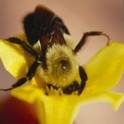
Mutualisms are key interactions that affect population dynamics and structure communities, but the extent to which mutualists can attract potential partners may depend on community context. Many studies have shown that leaf herbivory reduces pollinator visitation and have focused on reduced fl oral visual display and rewards as potential mechanisms. However, olfactory display plays a critical role in mediating interactions between plants, herbivores, and pollinators. We simulated leaf damage in Cucurbita pepo subsp. texana and measured fragrance emission and other fl oral characters of both male and female fl owers. Contrary to our expectations, damage increased fragrance production, but only in male fl owers. Female fl owers, which were bigger and produced more fragrance than males, were unaffected by leaf damage. The greatest increase in fl oral fragrance compounds was in the terpenoids, which we hypothesize could be byproducts of defensively induced cucurbitacins, or they may function defensively themselves. In summary, this study is the fi rst to demonstrate changes in floral fragrance due to leaf damage. Such changes in floral fragrance following herbivory may be a critical and overlooked mechanism mediating interactions between plants, herbivores, and pollinators.
- acalymma vittatum,
- apis mellifera,
- cucurbita pepo subsp. texana,
- cucurbitaceae,
- diabroticite beetles,
- floral volatiles,
- generalist,
- honeybees,
- peponapis pruinosa,
- plant – insect interactions,
- specialist,
- squash bees
Available at: http://works.bepress.com/lynn_adler/14/
